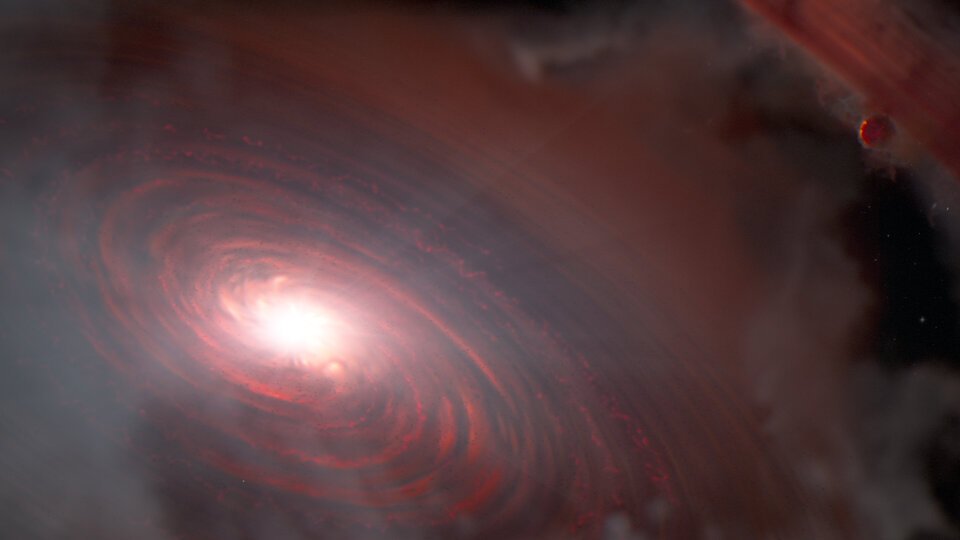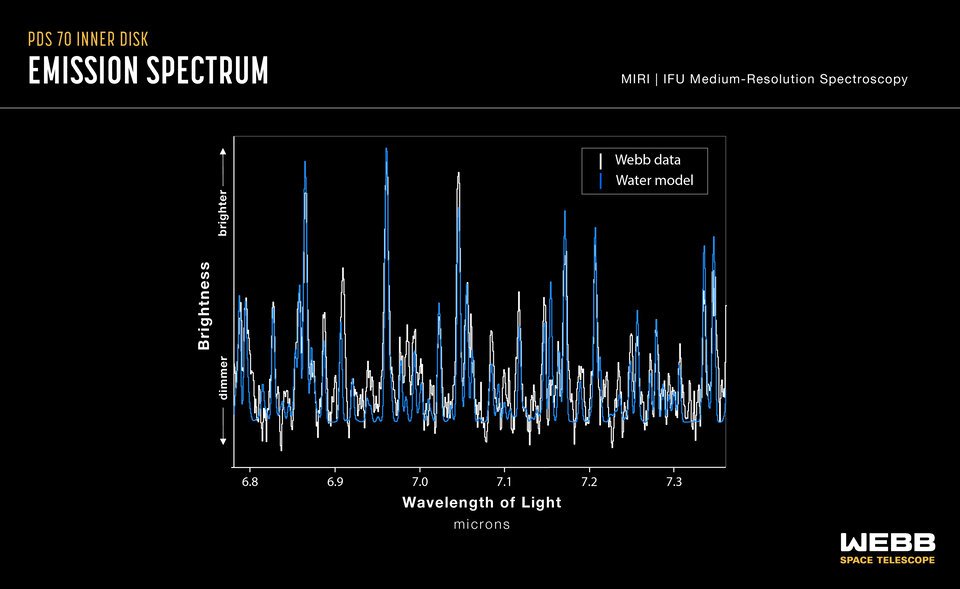The inner disc of the system PDS 70, rocky planets has been found with water vapours. And it is discovered by the Webb telescope. This is located 370 lightyears away.

If you want to read more about this discovery, and its impact on further scientific studies, then this blog post is intended for you. But, let’s read the latest news first!
Water Vapours Near Developing & Rocky Planets in Distant Star System
Scientists have found water in the area around a star that already has two or more developing planets. Water is crucial for life on Earth, and researchers are trying to understand its existence here. And if the same process happens on distant rocky planets orbiting other stars.
They’re studying the PDS 70 system. Which has an inner and outer disc with a gap of eight billion km between them. Within this gap, two gas-giant planets have been identified. Using MIRI, scientists detected water vapor in the inner disc, at distances of less than 160 million km from the star. This region is significant because it’s where rocky planets, similar to Earth, might be forming.
Giulia Perotti, the lead author from the Max Planck Institute for Astronomy (MPIA) in Heidelberg, Germany, said:
“We’ve observed water in other discs, but never this close and in a system where planets are actively forming. Thanks to Webb, we can now make this kind of measurement.”
Surprising Water Discovery Near Old Star Challenges & Rocky Planet Formation Theories
Henning is also the co-principal investigator of Webb’s MIRI (Mid-InfraRed Instrument) and the principal investigator of the MINDS (MIRI Mid-Infrared Disk Survey) program, which focuses on collecting data related to rocky planets.
Thomas Henning, the MPIA director and a co-author of the study, added:
“This discovery is incredibly exciting. Because it allows us to study the region where rocky planets, similar to Earth, typically come into existence.”
PDS 70 is a type of star know as K-type, which is cooler than our Sun. It’s relatively old, about 5.4 million years old, especially for stars with planet-forming discs. The presence of water vapor in this system was surprising because as planet-forming discs age, they usually lose their gas and dust.
As time goes on, the material in these discs decreases either because the star’s radiation and winds push it away, or the dust starts clumping together to form larger objects like planets. Previous studies of similarly aged discs didn’t find any water in their central regions, leading astronomers to suspect that harsh stellar radiation might have evaporated the water, making it difficult for rocky planets to form in such dry conditions.
If you want to know more about the composition of these rocky planets, and their building blocks, then the following part will highlight it.
Water Vapor and Building Blocks Found Around Star PDS 70 ( Rocky Planets)
Astronomers have not yet found any planets forming close to a star called PDS 70, but they have discovered the building blocks for rocky worlds, known as silicates. They also detected water vapor, suggesting that if rocky planets are forming there, they will have water right from the start.

One of the researchers, Rens Waters from Radboud University in the Netherlands, said they found a lot of tiny dust grains in the inner disc and combined with the presence of water vapor, it makes the inner disc a fascinating place to study.
What Could be the Potential Source & Cause of this Water?
Now, scientists are investigating the origins of this water on rocky planets. They have two possible explanations for its presence. One idea is that water molecules are being formed within the inner disc as hydrogen and oxygen atoms combine. The other possibility is that dust particles coated with ice are migrating from the cooler outer disc to the hotter inner disc. Upon reaching the inner disc, the water ice sublimates into vapor. This scenario is surprising because the dust would need to traverse a significant gap created by two giant planets.
The discovery also raises the question of how water can survive so close to the star, where the star’s ultraviolet light could break apart water molecules. The team believes that surrounding materials like dust and other water molecules act as a protective shield, allowing the water to survive on rocky planets.
To learn more, the team plans to use two of Webb’s other instruments, the Near-InfraRed Camera (NIRCam) and the Near-InfraRed Spectrograph (NIRSpec) to study the PDS 70 system. These findings were part of the Guaranteed Time Observation program 1282.
The following part of the blog will highlight the significant information about the Webb Telescope, and its remarkable contributions. So, let’s read it too!
ESA’s Key Role in Launching Webb Telescope- That is Where International Collaboration Makes History
The Webb telescope is the largest and most potent telescope ever launched into space, designed specifically to explore distant rocky planets. It is a collaborative effort between NASA, ESA, and the Canadian Space Agency (CSA). The Ariane 5 launch vehicle was used to launch the telescope as part of this collaboration.
ESA played a significant role in the Webb mission, particularly in adapting and qualifying the Ariane 5 rocket for this purpose. Additionally, ESA procured the launch service through Arianespace. They also contributed crucial instruments to Webb, including the spectrograph NIRSpec and half of the mid-infrared instrument MIRI, which was developed by a group of European Institutes known as the MIRI European Consortium in partnership with JPL and the University of Arizona. This international collaboration was instrumental in making Webb a reality, pooling together the expertise and resources of multiple space agencies to create this remarkable telescope, crucial for the study of rocky planets.





